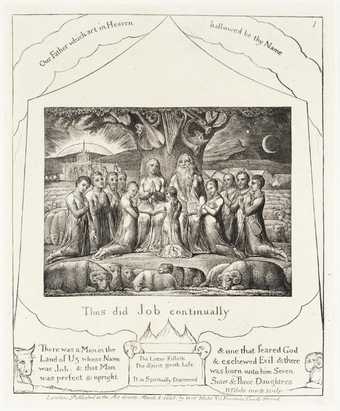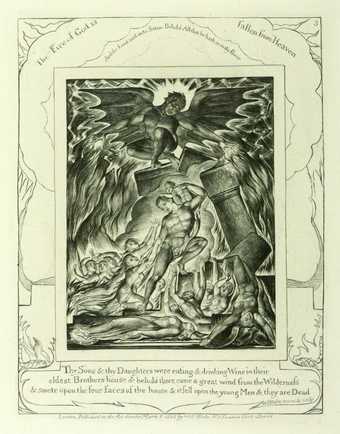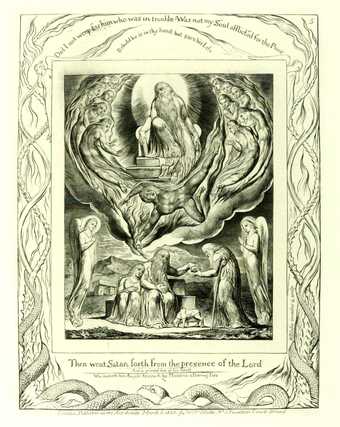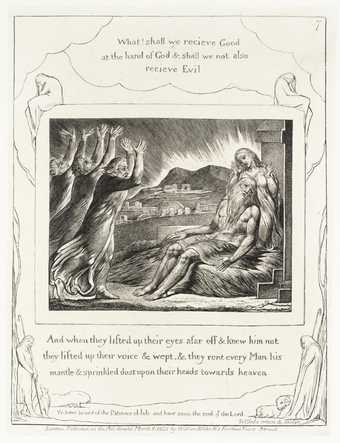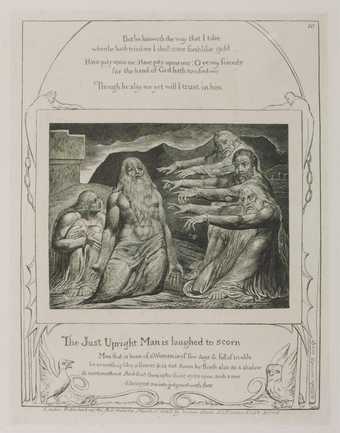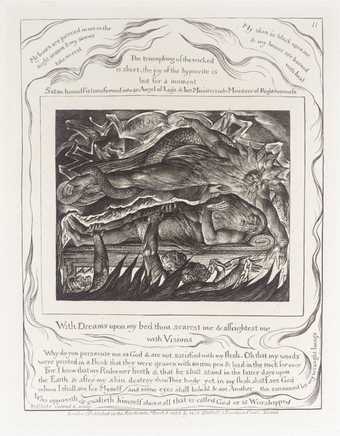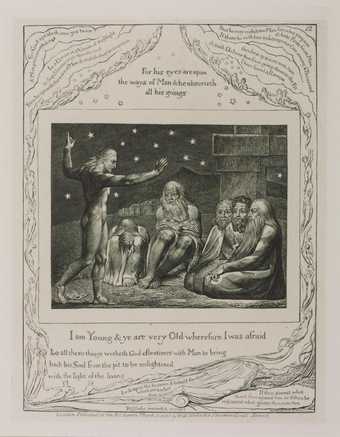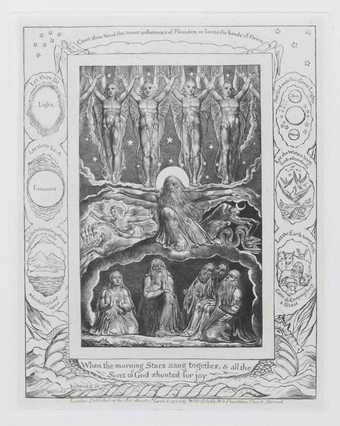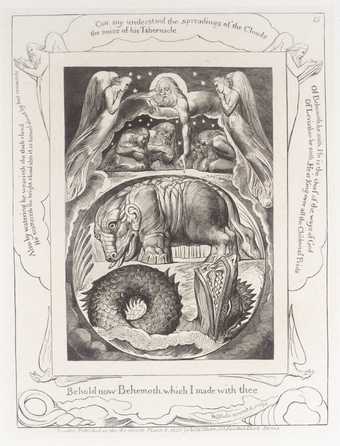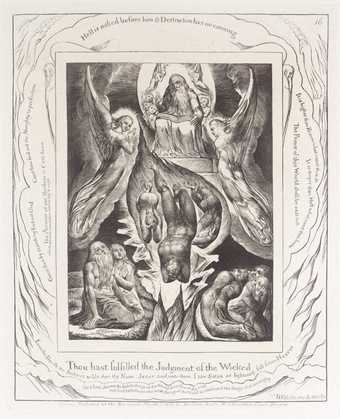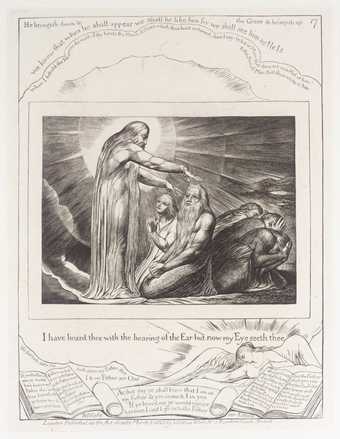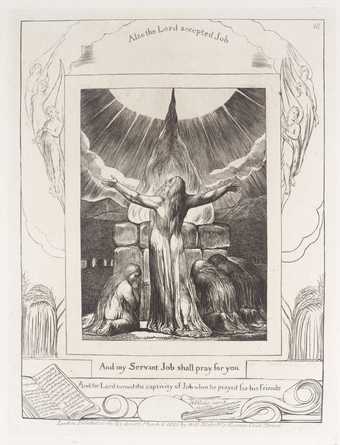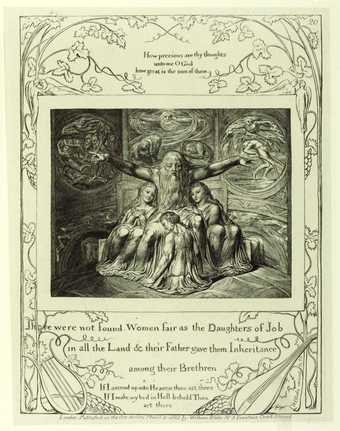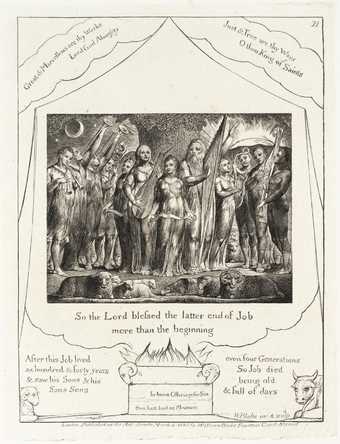
In Tate Britain
Prints and Drawings Room
View by appointment- Artist
- William Blake 1757–1827
- Medium
- Line engraving on paper
- Dimensions
- Image: 198 × 151 mm
- Collection
- Tate
- Acquisition
- Purchased with the assistance of a special grant from the National Gallery and donations from the Art Fund, Lord Duveen and others, and presented through the Art Fund 1919
- Reference
- A00024
Display caption
This is an illustration of the opening words of chapter 38 of the Book of Job. Blake quotes them in the main title of the print. The Lord appears and asks Job a series of questions, opening with 'Where wast thou when I laid the foundations of the earth?' The clockwise action of the Lord's appearance in the whirlwind permeates the whole of Blake's image. The trees in the bottom margin are bent low by the force of the wind, but, like Job in his adversity, they remain unbroken.
Gallery label, August 2004
Does this text contain inaccurate information or language that you feel we should improve or change? We would like to hear from you.
Catalogue entry
A00024 [from] Illustrations to The Book of Job: Engravings
1823–6/1874 [A00012-A00032; T05845; complete]
A 00012–32 /-
Twenty-two line engravings on india paper laid on drawing paper approx. 510×345 (20×13 1/2)
Purchased with the assistance of a special grant from the National Gallery and donations from the National Art-Collections Fund, Lord Duveen and others, and presented through the National Art-Collections Fund 1919
PROVENANCE John Linnell; his heirs, sold Christie's 15 March 1918 (183) £33.12.0.bt Martin for the donors
LITERATURE Gilchrist 1863, 1, pp.283–4, 297; Wicksteed 1910 and 1924; Russell Engravings 1912, 102–15 no.33: Keynes Bibliography 1921, pp.179–82 no.55: Binyon and Keynes 1935, series repr. vol.VI; Keynes Engravings 1950, pp.16–17, series repr.pls. 42–68; Keynes Writings 1957, pp.869–70, 872, 874, 876–7; S. Foster Damon, Blake's Job 1966, series repr.; Bentley Blake Records 1969, pp.234 n.i, 277–397 passim, 586–605; Andrew Wright Blake's Job: A Commentary 1972, series repr.; Lindberg 1973, pp.24–32, 40–52, 167–76, 183–352 nos.0A–21A, series repr.; Bentley Blake Books 1977, pp.517–24 no.421; Bindman Graphic Works 1978, pp.486–7 nos.625–46, series repr.; Mitchell 1978, pp.41–2; Essick Printmaker 1981, pp.92, 105, 220, 234–50, 252; Robert N. Essick, ‘Blake's Engravings to the Book of Job; An Essay on their Graphic Form with a Catalogue of their States and Printings’ in David Bindman, ed., William Blake's Illustrations of the Book of Job 1987, pp.35–101.
John Linnell, who had commissioned the second set of watercolour illustrations to the Book of Job in 1821, entered into a formal agreement with Blake for the engravings on 25 March 1823: Linnell was to pay Blake £5 a plate or £100 for the set, and in addition he agreed to give Blake an extra £100 if the profits of the work made this possible. The agreement was for twenty engravings though in the event twenty-one subjects were engraved together with a title-page. On 5 March 1825 Linnell went with Blake to the printer J. Lahee to see proofs being taken. The series is dated 8 March 1825 but the final engravings do not seem actually to have been ready until the end of March 1826 (Bentley 1969, pp.277, 300 and 327). At this time 215 sets of engravings marked ‘Proof’ were issued; these should be distinguished from the working proofs, on some of which Blake tried out designs for the borders. The word ‘Proof’ was then deleted (traces can be seen on A00013) and a further 100 sets were printed on drawing paper. According to John Linnell Jr, writing to Bernard Quaritch on 6 May 1892, Linnell, after the 1826 printing, ‘put the plates away, & they were never again used after this time until the year 1874. At this time my father...had one hundred copies printed from the plates upon India paper’. Although the distinctive cover is now missing, it seems that the Tate Gallery's copies of the engravings are from this 1874 printing. The original plates were given by Herbert Linnell to the British Museum Print Room on 28 May 1919.
Each engraving is inscribed ‘W Blake inv. & sculp’. In addition each is inscribed in the lower margin with variations of the text ‘London. Published as the Act directs March 8:1825 by William Blake No3 Fountain Court Strand’; the first actual design (A00012) is mistakenly dated with the year 1828 and ‘Willm’ is sometimes substituted for ‘William’, while the punctuation is also slightly varied.
More importantly, the borders of each design bear a number of inscriptions taken from the Bible or with variations of biblical texts. These add a verbal gloss to the designs which in themselves embody Blake's critical reaction to the original story as set out in the Old Testament. The fullest analysis is in Lindberg though Wicksteed, Damon 1966 and Wright also contain full commentaries. Blake's interpretation of his text is only given in summary form in this catalogue.
These engravings were formerly inventoried as nos.3372 i–xxii. The new inventory numbers omit the title-page.
A00024 The Lord Answering Job out of the Whirlwind
Line engraving 198×151 (7 3/4×5 7/8); platemark 217×170 (8 9/16×6 13/16)
Inscribed ‘WBlake invenit & sculp’ b.r., ‘London Published as the Act directs March 8:1825 by William Blake No3 Fountain Court Strand’ below, ‘13’ t.r., and with texts given below
EXHIBITED Tate Gallery 1958 (200, repr.)
Illustration no.13: Job, xxxviii, i, the source of Blake's main title, ‘Then the Lord answerd Job out of the Whirlwind’. This quotation is continued by a line from the Psalms, civ, 3, ‘Who maketh the Clouds his Chariot & walketh on the Wings of the Wind’. The other quotations are from the Book of Job: ‘Hath the Rain a Father & who hath begotten the Drops of the Dew’ (Job, xxxviii, 28), and ‘Who is this that darkeneth counsel by words without knowledge’ (Job, xxxviii, 2).
The Lord appears in a new, active guise, questioning Job's lack of illumination and asking rhetorical questions about the Creation. The whirlwind has flattened the trees in the margin but, though bowed, they are not broken, just as Job has remained unbroken under adversity. In an early state of the engraving Blake showed the whirlwind bursting out of the central design into the margin above to much greater effect, but in the end he reverted to the usual clearly defined rectangle for the main design (repr. Bindman 1978, pl.638b).
Blake had already treated this subject in his watercolour painted for Thomas Butts c.1803–5, ‘Job confessing his Presumption to God who Answers from the Whirlwind’, now in the National Gallery of Scotland, Edinburgh (Butlin 1981, no.461, colour pl.538). The composition is completely different and the Lord is accompanied by angels. Job's wife, like the friends, bows down to the ground in fear rather than sharing in Job's vision.
Published in:
Martin Butlin, William Blake 1757-1827, Tate Gallery Collections, V, London 1990
Explore
- people(22,072)
-
- actions: expressive(2,622)
- actions: postures and motions(9,111)
- adults(20,120)
- body(4,878)
-
- beard(206)
- groups(5,156)
-
- group(4,227)
- Bible: Old Testament(381)
-
- Job, chapter 38(2)
- Psalms, 104(1)
- God(152)
- inscriptions(6,664)
-
- caption(358)
- printed text(1,138)
- quotation(297)
You might like
-
William Blake Job and his Family
1828, reprinted 1874 -
William Blake Satan before the Throne of God
1825, reprinted 1874 -
William Blake Job’s Sons and Daughters Overwhelmed by Satan
1825, reprinted 1874 -
William Blake Satan Going Forth from the Presence of the Lord, and Job’s Charity
1825, reprinted 1874 -
William Blake Job’s Comforters
1825, reprinted 1874 -
William Blake Job Rebuked by his Friends
1825, reprinted 1874 -
William Blake Job’s Evil Dreams
1825, reprinted 1874 -
William Blake The Wrath of Elihu
1825, reprinted 1874 -
William Blake When the Morning Stars Sang Together
1825, reprinted 1874 -
William Blake Behemoth and Leviathan
1825, reprinted 1874 -
William Blake The Fall of Satan
1825, reprinted 1874 -
William Blake The Vision of Christ
1825, reprinted 1874 -
William Blake Job’s Sacrifice
1825, reprinted 1874 -
William Blake Job and his Daughters
1825, reprinted 1874 -
William Blake Job and his Family Restored to Prosperity
1825, reprinted 1874

